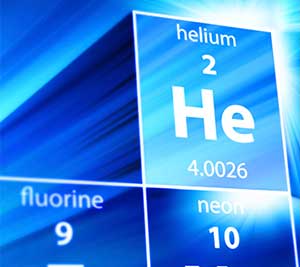The success of the APS-ACS Liquid Helium Purchasing Program sparks movement toward helium recycling
By Rachel Gaal
After a successful test-run ending in late May 2016, the Liquid Helium Purchasing Program is now in full swing, syncing reliable deliveries and discounted liquid helium to an expanded network of academic users within the United States. The program is a partnership of APS, the American Chemical Society (ACS), and the U.S. Defense Logistics Agency (DLA).
“It started as a pilot program with 7 institutions,” recalled Mark Elsesser, the APS senior policy analyst who oversees the purchase program. “Now we are into the second iteration of the program with 12 universities — for us it’s been a great success, and members are now enrolled for two years, receiving helium from the DLA through May 31, 2018.”
The partnership is built upon short-term concerns: The increasing cost of helium and erratic delivery schedules have placed burdens on physicists and other researchers at their home institutions. Acting as a brokerage, the partnership allows the DLA to negotiate liquid helium contract terms on behalf of academic researchers — saving the program’s enrollees an average of 15 percent.
Elsesser emphasizes that the problem of liquid helium supply is far from resolved. “Long term, there are still issues — as helium prices go up, [principal investigators] are spending more and more of their grants on helium, and this is unsustainable,” he says.
To tackle this looming concern, the APS Office of Public Affairs (OPA) approached ACS and the Materials Research Society (MRS) to investigate what it would take to transition users into using less helium, by means of recycling and reuse.
Recently, a new helium deposit was discovered in the Tanzanian Rift Valley, a find that some argue solves the helium shortage. As much as 10 percent of a sizable 54 billion cubic feet gas source is helium. Geologists from Oxford and Durham universities are working to pinpoint the estimated areas where the trapped helium in the valley’s rocks could be exploited in shallower gas fields, marked by frequent seismic activities.
“The recent discovery [of a new deposit] in Tanzania doesn’t change the fact that helium is an irreplaceable, nonrenewable resource,” mentions Elsesser. “That’s why this issue of helium recycling and reuse is so important. My hope is that we can transition more of our users to systems with recycling capabilities, so their future helium purchases will be smaller and more inexpensive.”
APS OPA, together with ACS and MRS, plans on releasing a science policy report within the next few months, detailing the long-term effort to move users toward systems that have the capability to recycle and re-liquefy helium being used in experiments.
The program’s success in attracting buyers has led other liquid helium vendors to reduce their prices even further to bring back previous customers. While this means potential rivalries in store for the purchase program, the end result will be more liquid helium alternatives for researchers in academic institutions in future years.

©1995 - 2024, AMERICAN PHYSICAL SOCIETY
APS encourages the redistribution of the materials included in this newspaper provided that attribution to the source is noted and the materials are not truncated or changed.
Editor: David Voss
Staff Science Writer: Rachel Gaal
Contributing Correspondent: Alaina G. Levine
Art Director and Special Publications Manager: Kerry G. Johnson
Publication Designer and Production: Nancy Bennett-Karasik

